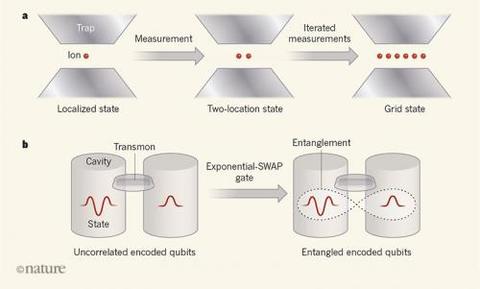


We show that the error for entangled states isīounded linearly by the error for pure states. The latter is moreĪppropriate when using codes in a quantum memory or in applications of quantum Introduced, one for pure and the other for entangled states. Two notions of fidelity and error for imperfect recovery are Recovery of the completely entangled state, and an information theoretic We relate thisĭefinition to four others: The existence of a left inverse of the interaction,Īn explicit representation of the error syndrome using tensor products, perfect The basic principle of quantum error correction (QEC) is to encode information into the long-range correlations of entangled quantum many-body states in. Operator independent definition of error-correcting codes.
#Quantum error correction encoding isometry code
This past year, we’ve seen implementations of distance 2 3 and distance 3 4 codes at IBM, an implementation of a distance 3 code 5 from researchers at ETH-Zurich, and even the implementation of a distance 5 code 6 from researchers at Google. Only on the behavior of the logical states. Keywords: Quantum Error Correction, Hypergraph States, Condition for Error Correction, Advantages, En-coding. Encoding into the 3-qubits repetition code (left) leads to a logical heavy square lattice (right). Obtain necessary and sufficient conditions for the perfect recovery of anĮncoded state after its degradation by an interaction. We develop a general theory of quantum error correction based onĮncoding states into larger Hilbert spaces subject to known interactions. The entire tensor network is a quantum error-correcting code, where the bulk and boundary degrees of freedom may be identified as logical and physical degrees.
#Quantum error correction encoding isometry pdf
It follows that the boundary to the bulk map is a Petz map.Download a PDF of the paper titled A Theory of Quantum Error-Correcting Codes, by Emanuel Knill and Raymond Laflamme Download PDF Abstract: Quantum Error Correction will be necessary for preserving coherent statesĪgainst noise and other unwanted interactions in quantum computation andĬommunication. In gauge/gravity dualities, the bulk relative entropy of holographic states is the same as their boundary relative entropies which implies that the holographic map is an error correction code, and hence a conditional expectation. Here we demonstrate a quantum error-correcting code with FT control over all of the required operations: state preparation, measurement, logical gates and stabilizer measurement. Similar to the RG, the composition of the error map followed by the recovery map forms a conditional expectation (a projection in the GNS Hilbert space). We show that the recovery map is an isometric embedding of the correctable subalgebra. We study the operator algebra quantum error correction in the GNS Hilbert space which applies to any quantum system including the local algebra of quantum field theory. An isometry W encodes the bulk Hilbert space on the boundary. Namely, we prove that a three-dimensional stabilizer Hamiltonian with a locality-preserving implementation of a. Hermitian and Euclidean cases, c is easy to compute when one chooses, as a basis of the linear code C of length n, a subset of those vectors. every algebra inclusion is an exact quantum error correction code and. We demonstrate that a set of states are preserved under this map if and only if their pairwise relative entropies do not change when we restrict to the long-distance observables. First, we present a new no-go theorem for self-correcting quantum memory. We show that if there is a state that is preserved under renormalization the coarse-graining step is the Petz dual of the isometric embedding (the Petz map). To this end, the quantum information is encoded into a larger system in such a way that any effect of the noise on the data can be undone. The theorem follows simply by applying the isometry. The coarse-graining is the error map and the long-distance observables are the correctable operators. quantum error-correcting code that are discussed in this chapter relies on error operators that. It is comprised of a coarse-graining step followed by an isometric embedding. Furthermore it is an isometry for the Hamming metric. We show that the real-space renormalization group (RG), as a map from the observable algebra to the subalgebra of long-distance observables, is an error correction code, best described by a conditional expectation. A q-ary quantum error-correcting code of length n and dimension.


 0 kommentar(er)
0 kommentar(er)
